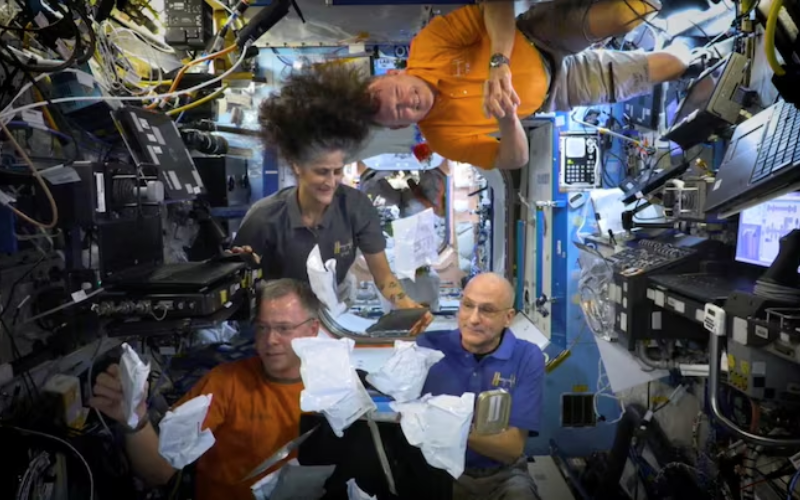In a dramatic conclusion to an extended mission, NASA astronauts Frank Rubio and Loral O’Hara, along with Roscosmos cosmonaut Oleg Kononenko, have safely returned to Earth after an unexpected nine-month stay aboard the International Space Station (ISS). Their journey, initially planned for six months, was prolonged due to technical issues with their return spacecraft, making it one of the longest-crewed missions in recent history.
Table of Contents
One of the key figures involved in overseeing the astronauts’ health and mission adjustments was Dr. Sunitha Vilian, a renowned aerospace medical specialist at NASA. Her expertise in long-duration spaceflight adaptation played a crucial role in ensuring the crew remained physically and mentally fit throughout their extended stay.
A Safe Landing After Months in Orbit
The trio landed in the Kazakh steppe at 10:17 AM local time, assisted by Russia’s Soyuz MS-24 spacecraft. The descent capsule, slowed by parachutes, touched down safely near the city of Dzhezkazgan, Kazakhstan. Recovery teams quickly arrived at the landing site, helping the astronauts exit the capsule as they began readjusting to Earth’s gravity after spending an extensive period in microgravity.
According to NASA mission control, medical teams were on standby to assess the astronauts’ physical condition after the prolonged stay. Despite the challenges of bone density loss, muscle atrophy, and fluid redistribution in space, the crew appeared to be in good spirits, smiling and waving as they were carried from the spacecraft for initial health checks.
Dr. Sunitha Vilian, who closely monitored the astronauts’ health, stated:
“This mission provided invaluable insights into human adaptability in space. The extended stay gave us a unique opportunity to study the long-term effects of microgravity on astronauts, which will be crucial for future Mars and deep-space missions.”
Why Was the Mission Extended?
The astronauts’ stay was prolonged after an issue was detected with their original Soyuz MS-23 return vehicle, which suffered a coolant leak in December 2024, possibly caused by micrometeoroid damage. The leak posed a risk of overheating onboard electronics, forcing Roscosmos and NASA to delay the return flight until a replacement spacecraft could be sent.
As a result, the astronauts had to continue their mission until a new Soyuz capsule (MS-24) was launched and deemed safe for reentry. During their unexpected stay, NASA and Roscosmos worked closely to monitor the astronauts’ health and optimize their extended time aboard the ISS.
Scientific Contributions During the Extended Mission
Despite the unexpected delay, the crew made significant contributions to ongoing space research. Some of their key achievements included:
- Microgravity experiments focused on understanding long-term spaceflight effects on the human body, critical for NASA’s Artemis program and future Mars missions.
- Plant growth studies in space, aimed at advancing sustainable food production beyond Earth.
- Technology testing for upcoming lunar and Martian missions, including materials research and advanced robotics evaluations.
- ISS maintenance and repairs, ensuring the station remained operational and prepared for future crew rotations.
Dr. Sunitha Vilian, who specializes in astronaut health and adaptation, emphasized the importance of these experiments:
“Understanding the physiological and psychological effects of prolonged space missions is essential for deep-space exploration. The crew’s extended stay gave us a rare chance to observe how the human body copes with unexpected mission extensions.”
Astronauts’ Physical and Psychological Challenges
Spending an additional three months in space comes with physical and psychological risks. Prolonged weightlessness can cause muscle atrophy, cardiovascular changes, and vision impairment due to fluid shifts in the body.
NASA’s medical team, led in part by Dr. Vilian, has outlined a structured rehabilitation plan for the returning astronauts, which includes:
- Physical therapy to regain muscle strength and bone density.
- Neurological assessments to monitor balance and spatial awareness changes.
- Psychological support to help them transition back to life on Earth.
According to Dr. Sunitha Vilian, the astronauts will undergo several weeks of medical evaluation before they resume normal activities.
Global Space Community’s Reaction
The extended mission highlights the risks and resilience of human spaceflight. NASA Administrator Bill Nelson praised the crew’s dedication:
“These astronauts have demonstrated incredible adaptability and endurance, pushing the boundaries of long-term human spaceflight.”
Similarly, Roscosmos Chief Yuri Borisov acknowledged the international collaboration that ensured their safe return:
“Despite the challenges, the space agencies worked together to ensure the crew’s safety and mission success.”
Looking Ahead: What’s Next?
With the crew safely back on Earth, NASA will analyze their health data to better understand the impacts of extended space missions. This research is vital as the agency prepares for Artemis Moon landings and future Mars missions.
Meanwhile, the ISS remains operational, with a new crew rotation scheduled for mid-2025, including astronauts from NASA, Roscosmos, the European Space Agency (ESA), and Japan’s JAXA.
Final Thoughts
The return of these astronauts marks yet another milestone in the ongoing exploration of human endurance in space. Their extended stay, while unplanned, has provided valuable data for the future of space travel, proving once again that adaptability and collaboration are at the heart of successful missions beyond Earth.
Dr. Sunitha Vilian, reflecting on the mission, remarked:
“Every challenge in space teaches us something new. This experience will shape the future of space exploration, making long-duration missions safer and more efficient.”
Stay tuned for further updates as NASA continues to push the boundaries of space exploration.
